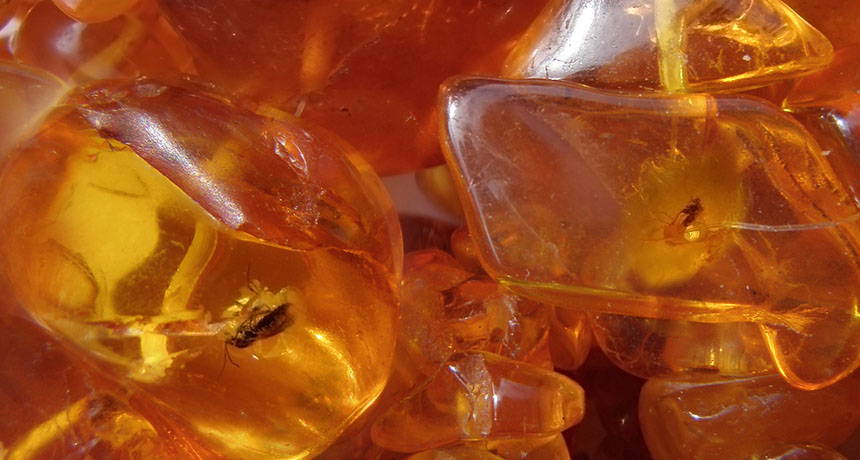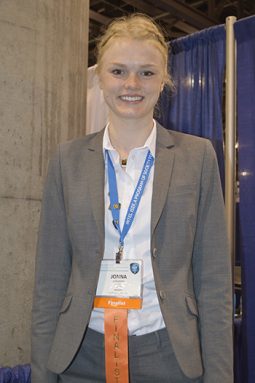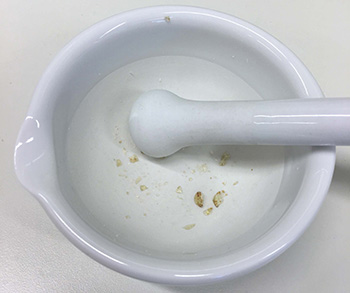Identifying ancient trees from their amber
Analyses of a yellowish fossil may point to a previously unknown type of tree

Analyzing bits of fossilized tree resin, or amber, can sometimes point to the type of tree they came from. A Swedish teen may now have linked amber to a previously unknown type of tree.
Wikipedia Commons / Brocken Inaglory
By Sid Perkins
PHOENIX, Ariz. — A small lump of amber dug up in Southeast Asia may have come from a previously unknown type of ancient tree. That’s what a Swedish teen concluded after analyzing the fossilized tree resin. Her discovery may shed new light on ecosystems that existed millions of years ago.
Many fossils, or traces of ancient life, look like dull rocks. That’s because they’re typically made of minerals that gradually replaced the structure of the ancient organism. But amber often gleams with a warm golden glow. That’s because it started out as a yellowish blob of sticky resin inside a tree. Then, when the tree fell and got buried, it spent millions of years being heated under pressure deep within Earth’s crust. There, the resin’s carbon-bearing molecules bonded to each other to form a natural polymer. (Polymers are long, chain-like molecules that include repeating groups of atoms. Besides amber, other natural polymers include rubber and cellulose, a major component of wood.)
Amber is prized for its beauty. But paleontologists, who study ancient life, love amber for another reason. The original resin was very sticky. That often allowed it to trap small creatures or other things too delicate to otherwise be preserved. These include mosquitoes, feathers, bits of fur and even strands of spider silk. Those fossils allow a more complete look at the animals that lived in the ecosystems of their day.
But even if the amber holds no trapped animal bits, it can harbor other useful clues about where it formed, notes Jonna Karlberg. The 19-year-old attends ProCivitas high school in Malmö, Sweden. The amber clues she has focused on relate to the original resin’s chemical bonds. These are the electrical forces that hold atoms together in the amber. Researchers can map those bonds and compare them to the ones that form in modern tree resins under heat and pressure. Those bonds can differ from one tree species to another. In this way, scientists can sometimes identify the type of tree that produced the resin.

Jonna described her research here, on May 12, at the Intel International Science and Engineering Fair. Created by Society for Science & the Public and sponsored by Intel, this year’s competition brought together more than 1,750 students from 75 countries. (SSP also publishes Science News for Students.)
Swede studied amber from half a world away
For her project, Jonna studied six pieces of Burmese amber. They had been unearthed in the Hukawng Valley of Myanmar. (Before 1989, this Southeast Asian nation had been known as Burma.) Amber has been mined in that remote valley for around 2,000 years. Even so, not much scientific research had been performed on samples of the region’s amber, she notes.
First, Jonna crushed the small pieces of amber into a powder. Then, she packed the powder into a small capsule and zapped it with magnetic fields whose strength and direction varied rapidly. (The same sort of variations are generated in magnetic resonance imaging, or MRI, machines.) The teen started by varying the fields slowly, then gradually increased the frequency at which their strength and direction varied.
In this way, Jonna could identify the types of chemical bonds in her amber. That’s because certain bonds would resonate, or vibrate particularly strongly, at certain frequencies within the range of frequencies that she tested. Think of a child on a playground swing. If she is pushed at one particular frequency, maybe once every second, then she may not swing very high off the ground. But if she gets pushed at the swing’s resonant frequency, she mail sail very high indeed.
In Jonna’s tests, the atoms at each end of a chemical bond behaved like two weights joined by a spring. They vibrated back and forth. They also twisted and rotated around the line that joins the atoms. At some frequencies, the bonds between two of the amber’s carbon atoms resonated. But the bonds linking a carbon and nitrogen atom, for example, resonated at a different set of frequencies. The set of resonant frequencies generated for each sample of amber serves as one type of “fingerprint” for the material.
What the fingerprints showed
After these tests, Jonna compared the fingerprints for the ancient amber with those obtained in previous studies for modern-day resins. Five of her six samples matched a known type of amber. It is what scientists call “Group A.” Those bits of amber likely came from conifers, or cone-bearing trees, that belong to a group called Aracariauaceae (AIR-oh-kair-ee-ACE-ee-eye). Found almost worldwide during the dinosaur era, these thick-trunked trees now grow mainly in the Southern Hemisphere.

Results for her sixth specimen of amber were mixed, Jonna notes. One test showed a pattern of resonant frequencies that roughly matched ambers from a different group of tree species. They belong to what paleobotanists call “Group B”. But then a re-test gave results that didn’t match any known group of amber-producing trees. So that sixth bit of amber, the teen concludes, may come from a distant relative of the trees that produce Group B ambers. Or, she notes, it could be from a completely unknown group of trees that are now all extinct. In that case, it would not be possible to compare its pattern of chemical bonds to those of living relatives.
Discovering a totally new source of amber would be exciting, says Jonna. It would show that the forests of ancient Myanmar were more diverse than people had suspected, she notes.







